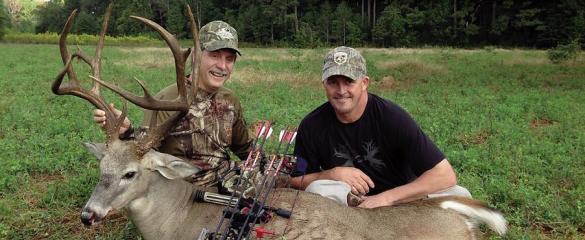Marty Fischer | Originally published in GameKeepers: Farming for Wildlife Magazine. To subscribe, click here.
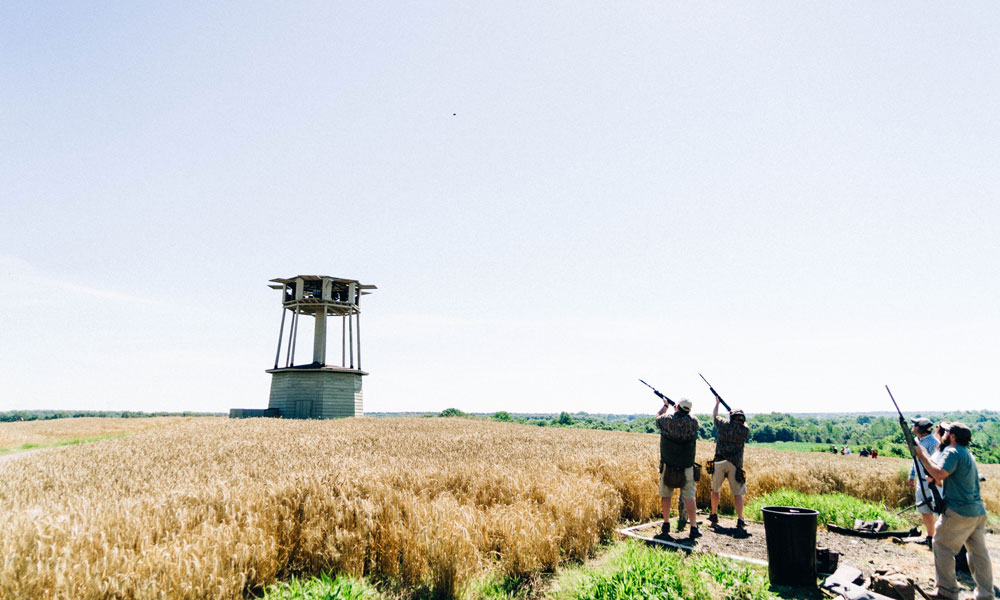
It has been many years, but I can still remember the first time I ever shot at a flying “clay pigeon.” My dad had purchased an inexpensive clay target trap that would throw one or two clay targets between 40 and 50 yards. We went to a family-owned property in the country and absolutely had a blast shooting target after target.
Over the years I found myself invited on dove and quail hunts, and at some of the hunt locations the property owners had either a trap or skeet field on site where hunters could shoot before the hunt. Fast forward to now and you will find that times have changed – for the better!
As more and more of us are purchasing rural properties and developing and managing them for recreation and wildlife, clay target ranges (trap, skeet, 5-stand, sporting clays, etc.) are often a part of the overall master plan. Of course, putting in a clay shooting venue on your property with the gamekeeper philosophy in mind is much more than putting clay traps on the ground and yelling “pull.” Let’s take a closer look at what is needed to build your own clay target range the right way. First of all, you will want to pick the right location on your land for the venue. You will want to decide what type or range you plan to build since some shooting games use more land than others. For instance, games like 5-stand sporting, trap, wobble trap or skeet are designed on a finite and fixed location. The actual acreage for them is very small, since they can be placed on a cleared spot that is 60 yards wide and about 70 yards deep. Keep in mind, however, that those dimensions are only for where the shooters stand and shots are taken from and do not include the possible shot fall area which must also be taken into consideration.
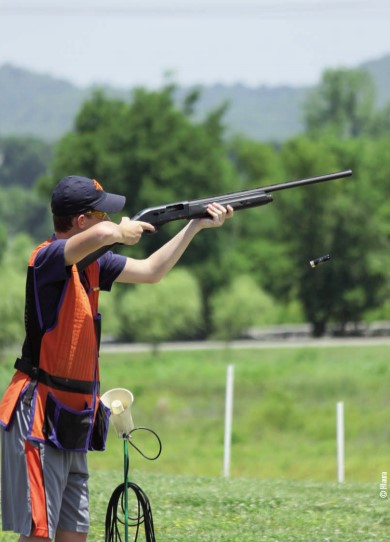
spectator safety in mind. Being cognizant about shot
direction and how shooters move around the shooting
venue is paramount.
Trap and skeet games only require pads for the shooters to stand on. The other shooting games are best shot using constructed shooting stands for the shooter to play from. These stands can be anything from an “H” shaped frame to protect the gun swing left to right, to elaborate shooting decks and stands that carry on the selected architectural theme of the property at hand.
Clay target ranges usually restrict shooters from using anything but target loads and shot sizes of 7 ½ and smaller. In the vast majority of instances, the pellets from these target loads will travel no more than about 725 feet when shot from the optimum muzzle elevation. To be safe, the NRA and other clay target associations recommend establishing a shot fall buffer zone of 900 feet from the point where the gun is fired. That will assure that all of the pellets are contained within a designated area on your property.
Since all of the major clay target games being played around the country can be installed on your property if you have the acreage, let’s take a closer look at each game.
Skeet
The game of skeet was developed in the early 1920’s by a group of bird hunters to simulate live bird shooting. The name “skeet” comes from the Norwegian word “skyte”, which means shoot. The military used the game in World War II to teach gunners how to lead flying objects. A skeet field consists of eight shooting positions around a semicircle, with another station in the middle. There are two traps: one positioned in a high house and another in a low house with both targets able to simultaneously cross the center of the field when launched. Shooters shoot single and double presentations as they move around the field and will shoot a total of 25 shells to complete a round. Many skeet fields are placed in open areas so the targets are always plainly visible to the shooter. Most of the shots are taken at 20-25 yards, so small pellets and open chokes are the norm for this popular game.
Trap
The game of trap was developed in America in 1831 when live birds were used in the game. The birds were placed under hats with a string tied to the hat so it could be pulled to release the pigeon into the air. The word “pull” which is used worldwide now to release clay targets from a trap came from this game. Live birds evolved into glass balls filled with feathers to simulate live pigeon shooting and eventually a clay pigeon was developed in 1880.
Today, a trap range consists of one thrower that oscillates left and right to give the shooter an unknown direction of the target when he calls for it. In trap, the targets go away from the shooter positioned 16 to 27 yards from the trap that throws a target at an elevation angle of around 35 degrees. Those distance changes increase the difficulty level as the shooter steps further back.
Wobble Trap
This is a very popular game at shooting preserves because it is similar to trap, but the targets are presented up, down, left and right as the trap not only oscillates side to side, it moves up and down as well. Usually the shooters are positioned much closer to the target than they would be in the regular trap game.
5-Stand Sporting
When sporting clays became popular in America, many gun clubs did not have enough acreage to install a sporting course. As a result, the 5- stand game became a sporting clays course placed on a skeet field. There are five shooting stands placed in a line about 15 feet apart. Six to eight throwers are used, including a rabbit machine to throw rabbit clays that bounce across the ground. This is a 25 target game, as shooters rotate to the shooting stand to their right every five targets. The presentation angles from one end of the field to the other, changing significantly as shooters move from one station to the next. The game also allows games like Flush and Flurry, where an automated trap release system can throw five shooters 125 targets in a matter of minutes. It sounds like an Argentina dove shoot, and shooters absolutely love it.
Sporting Clays
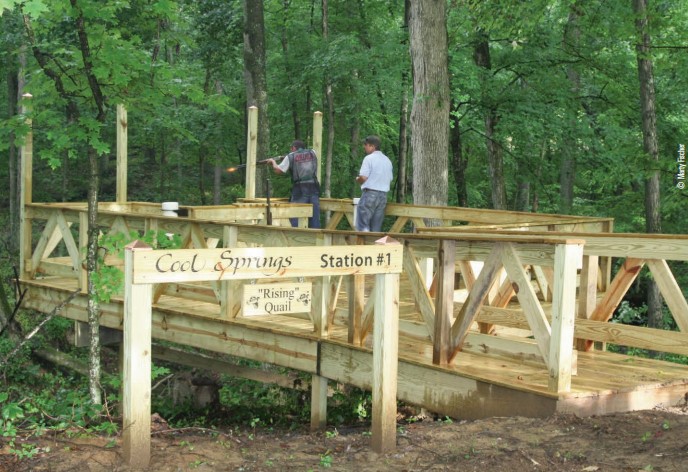
recreation and wildlife, clay target shooting is often a part of the overall master plan.
Perhaps the most popular clay target sport for hunters, the game of sporting clays, came to America from England in the early 1980’s. The game is known as “golf with a shotgun” because a sporting course moves across the land like a golf course, and usually features 10-15 shooting stations that replicate everything from doves to quail, pheasants, ducks and geese with clay pigeons. On a private level, a clays course can include any number of stations and targets the owner wishes to offer. Many of them feature 50 targets, but they can be as little as 25 or as many as 100 if the number of stations allow it.
Finding the Right Location
So let’s assume that some kind of clay target range is part of the master plan for your property. Finding the right location within the property lines so that the shooting and other activities can take place simultaneously is very important. All clay target venues must be designed with shooter and spectator safety in mind, so being cognizant about shot direction and how shooters move around a shooting venue is paramount.
When installing a venue other than a sporting course, careful attention should be made to find a location where the shooting will face as close to north as possible. When that orientation is used, there will be no issues with the sun at any time of the day. Shooters will tell you that there is nothing more frustrating than looking into the sun when shooting a clay target, and paying attention to shot direction can minimize the possibility of that happening. When designing a sporting clays course, the best sites contain a mix of woods and fields and the terrain is either flat or gently rolling. Many landowners who want to install a clay target venue like to offer shots over water when possible. While it is perfectly legal to shoot targets over water structures that are confined to your property, there are some instances where doing so can be problematic since having the lead pellets leave your property to be deposited elsewhere is a huge no-no. Since most clay targets are shot with lead ammunition, it is important to manage the dispensed lead pellets so that they cannot leach into the groundwater or be carried away and off of the property by erosion or running water like streams and rivers. Of course it is possible to use non-toxic steel target loads for clays and there will be no lead issue present.
The best way to manage the spent lead is either to remove it or keep the pH balance of the soil balanced where it is deposited. Either of these methods can be effective, and since private shooting venues almost never shoot as much as a commercial range, keeping the pH of the soil balanced is by far the most economical way to manage the lead.
What to do About the Broken Clays
If you’ve ever been to a commercial clays range, you have most likely encountered the thousands and thousands of broken target pieces and unbroken whole targets that are often visibly lying on the ground. It is rare that you will find this on a properly managed private shooting venue since they usually shoot less clays and tend to be more concerned about how the property looks on a daily basis. Standard clay pigeons are made primarily from limestone and petroleum pitch, so they are anything but biodegradable. Many shooting ranges either rake up the broken clays periodically or let the vegetation grow to a manageable height so that the clays are not as visible. Either of these land maintenance methods are perfectly acceptable.
A couple of decades ago, target manufacturers developed a line of biodegradable clays that have become popular with shooting clubs across the country. These clays are constructed of materials that will eventually break down and become a part of the ground. You will find, however, that they are high in sulfur content, and will eventually change the pH of the soil where they land. Additionally the sulfur residue that remains on the target sweep plate on the clay target traps can cause metal pitting if left unchecked. Bio targets are great when the soil pH balance and equipment are properly maintained.
Automated or Manual Equipment?
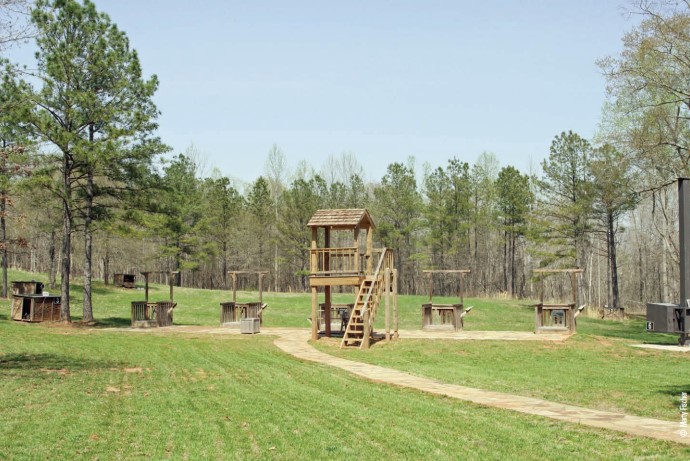
eight throwers are used, including a “rabbit machine” to throw clays that bounce across the ground.
If you are planning to install shooting games other than sporting clays, you will most likely choose to go with automatic traps that are powered either by 12V batteries with solar chargers or with 120V traps that are tied to your electric system.
The technology exists today to employ wireless remote control systems that totally eliminate wires and cables being placed on the ground. These wireless products are very dependable and certainly take away the headaches of cut cables when mowing grass and the chance of small rodents chewing the cables and shorting out the traps. When sporting clays is designed and installed, landowners have the option of using either manual or automated machines. There are some great manual traps on the market, but they do require a trapper to sit on them to release the targets, cock and reload the machine. You will also need safety barriers between the shooter and trapper for his protection. Automated traps are more expensive and most machines will hold 250-400 clays. In the long run they are safer and more economical if you are throwing many targets to your friends and family. When using manual traps, only one machine is needed since it will throw both single and double target presentations. Stations on an automated course require two traps each, but the flexibility of target presentation is much greater with the automatic traps.
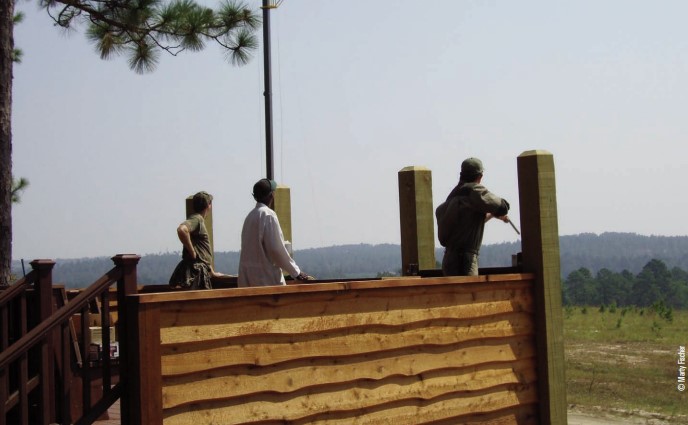
shooting from a 60 foot high tower. Diverse angles and numerous challenges make the game more fun
and develop our shooting skills.
Putting it all Together
Building a clay target range or venue can provide a great deal of recreation fun and practice for hunting, but doing it the right way requires much more than simply laying traps on the ground and pulling targets. A competent course designer can be worth his weight in gold as he can help with all aspects of the shooting venue including any necessary changes in zoning. Being a gamekeeper of your property includes all aspects of it, and while a shooting venue is a great recreational addition, putting a plan together that incorporates it into the overall management plan for the property just makes good sense.















